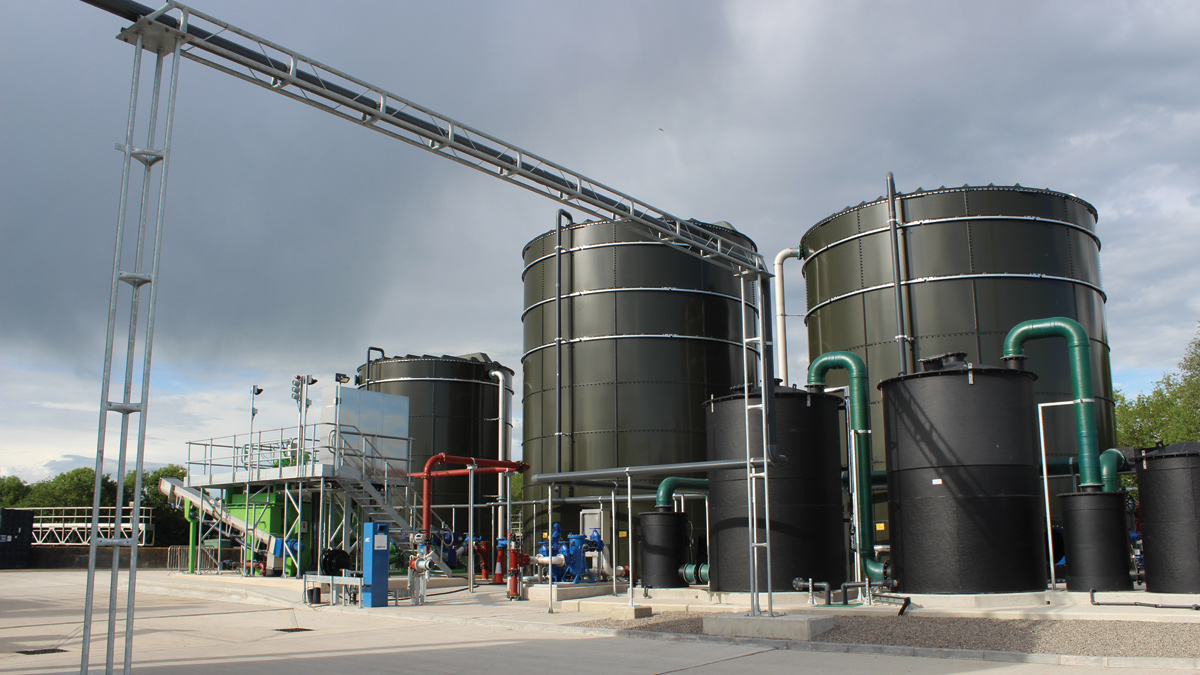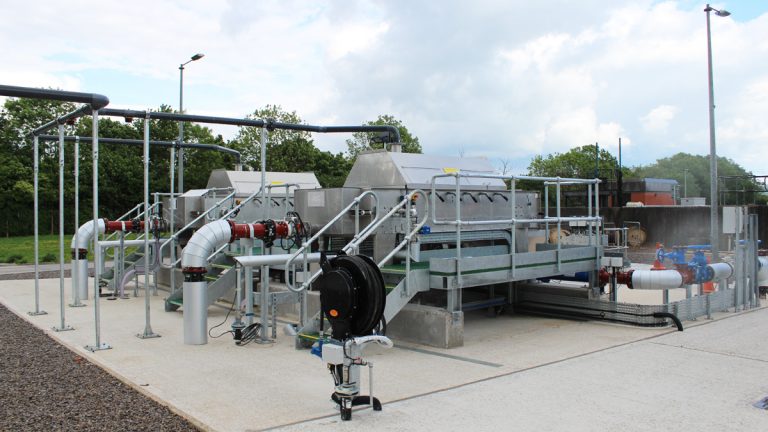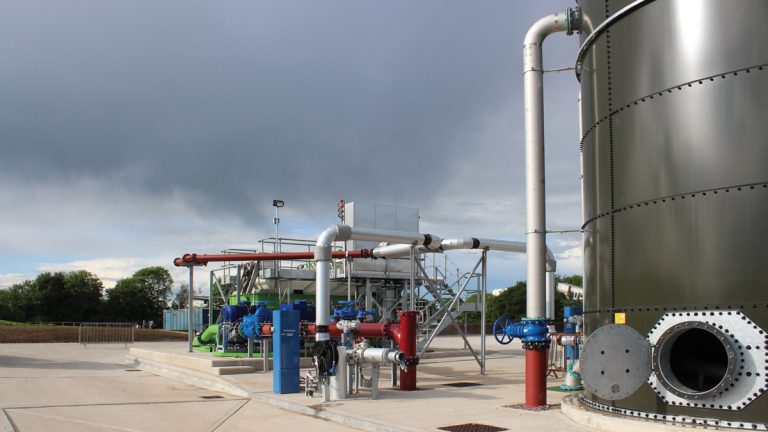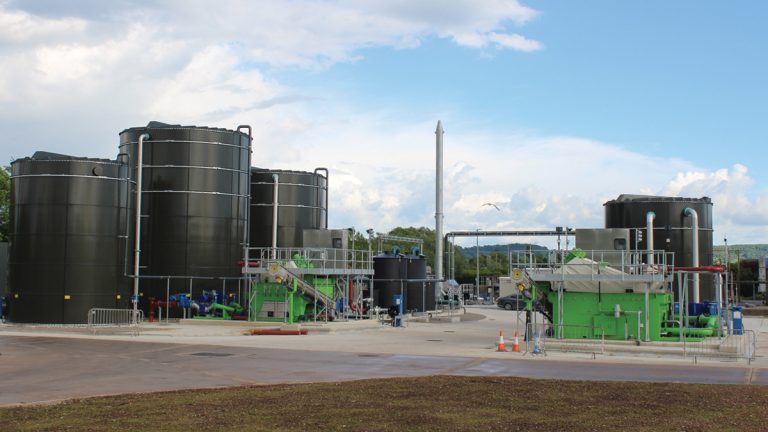Netheridge STW (2017)

Trade waste delivery area and storage tanks - Courtesy of Tom Pawson, Costain
Netheridge Sewage Treatment Works (STW) is one of Severn Trent Water’s key sites in the south west of the region serving the city of Gloucester, discharging final effluent to the River Severn. The works currently serves a population equivalent of 197,940 which is predicted to increase to 218,815 by the 2034-35 design horizon. The site is also a strategic sludge treatment centre for Severn Trent and processes inter-works sludge from over 100 regional STWs. It also processes trade waste from regional and national traders which are tankered to the site and treated by the digestion stream. Severn Trent invested in combined heat and power (CHP) engines during the AMP5 programme to maximise the energy generated from the biogas produced by the site digestion plant. Therefore, the facility provides a revenue stream to Severn Trent in addition to significantly reducing the site power imported from the grid.
Project background
Over the years the site has suffered from poor control of the digestion stream feed arrangement resulting in large fluctuations in the digesters’ gas production. This issue is exacerbated by the range of trade wastes which are accepted into the site, which can exceed COD values of 800,000mg/l.
The existing arrangement has been to blend the indigenous sludges, imported sludges and trade wastes in an attempt to control the digestion process. CiM6, a partnership between Costain and MWH (now Stantec UK) for AMP6, were awarded a contract to assess the existing digestion process and develop a solution to provide an improved sludge feed control system and maximise continuous gas production.
The project value is approximately £8.1m and was due for handover back to Severn Trent in the Spring of 2017.

Primary sludge gravity belt thickeners – Courtesy of Tom Pawson, Costain
Solution development
Working collaboratively with Severn Trent, CiM6 developed a solution that provides a new sludge and trade waste imports facility with additional sludge buffering and storage. A new control system has been implemented which ensures that flow and load into the digestion stream is controlled to maximise continuous gas production. In addition, improvements were delivered to the indigenous sludge route to ensure that both primary sludge and SAS are thickened to an optimum point of 6% dry solids. The solution overall comprises the following scope items:
- 6mm 2D sludge and trade waste screens for imports tanker discharges.
- Sludge and trade waste above ground tanks for buffer storage with pumped mixing.
- Progressive cavity transfer pumping stations.
- Primary sludge gravity belt thickeners.
- Powder polymer makeup system.
- Washwater filters.
- Odour control plant.
Using the concept of a ‘petrol forecourt’ design with multiple discharge points and a one way traffic management system, CiM6 developed the solution to be offline from the existing works processes during construction and commissioning to minimise interfaces and disruption to the day to day running of the works. Imported sludges into the facility are screened before being transferred into the pre-digestion blending tank.
Trade wastes are controlled differently; due to the high variability in COD values of the incoming trade wastes, imports are separated into medium strength and high strength wastes, with a COD value of 300,000mg/l being the cut off criteria between the two.
Using the quality monitors in the discharge loggers and the intelligent control system linked to the transfer pumps, the trade wastes are blended to provide a feed stock with an optimum COD value for the digestion process. Low strength trade waste continue to be discharged into the main treatment process.
The indigenous primary sludge is mechanically thickened to 6% dry solids using gravity belt thickeners with a polymer coagulant. Thickened indigenous sludge, imported sludge and trade waste are mixed in a pre-digestion blending tank before being fed to the digesters.
By optimising the digester feed to provide a consistently high calorific value sludge feed, gas production is maximised and managed within the site operations to generate electricity for both the site and the National Grid.

Sludge imports delivery area and storage tank – Courtesy of Tom Pawson, Costain
Collaborative planning and production control
In order to meet the efficiency demands of AMP6, CiM6 has embarked on a change programme, working with Severn Trent, to make collaborative planning and daily production control business as usual. Weekly production control sessions using lean techniques and software to bring programmes to the forefront of the design process helped to provide a focussed engineering stage prior to assembly.
Daily production control on site with the fully integrated supply chain teams helped meet a challenging programme and provide a consistent health and safety message to all construction workers.
Monitoring planned percentage complete metrics and utilising an active plan to protect and issue management workflow has allowed the project team to deliver the scheme under budget and achieving all the project outcomes.
Off site manufacture and design reuse
One of Severn Trent’s capital efficiency streams is to promote Design for Manufacture and Assembly (DfMA). The strategy has been actively pursued on the Netheridge Imports project to great effect. Assets such as the polymer mixing and dosing kiosk, imports screens, washwater filters and pump mechanical assemblies have all been manufactured and tested off site to reduce the installation time. In reducing time subcontractors spend on site, this approach has also reduced the risk of accidents and near misses, ensuring that this project remains a safe site for all construction workers.
The design for the sludge processing units has been an evolution from previous CiM6 projects for Severn Trent. The arrangement for the gravity belt thickeners and imports screens for example has previously been seen at Wanlip STW and the design for Netheridge has built on those successfully installed assets, taking feedback from operators and maintainers.

View of trade waste and sludge imports area and tank storage – Courtesy of Tom Pawson, Costain
Summary
Netheridge STW has long been a strategic site for Severn Trent in the south of the region with many outlying sites and traders relying on the successful operation of the site. The Netheridge Sludge Imports project will provide the site with additional trade waste imports capacity and assurance within the digestion process to allow Severn Trent to accept further trade waste in the future.
The improvements to the digester feed stock assets and the control functionality will give the site maximum opportunity to be a profitable and sustainable site for Severn Trent to operate.









